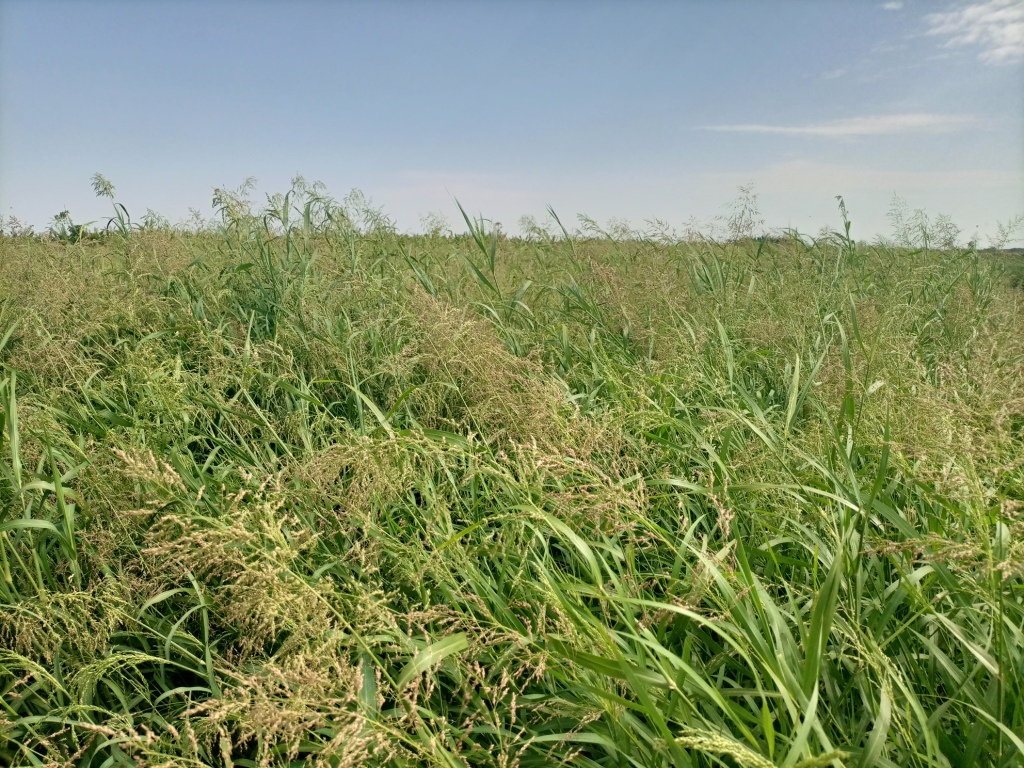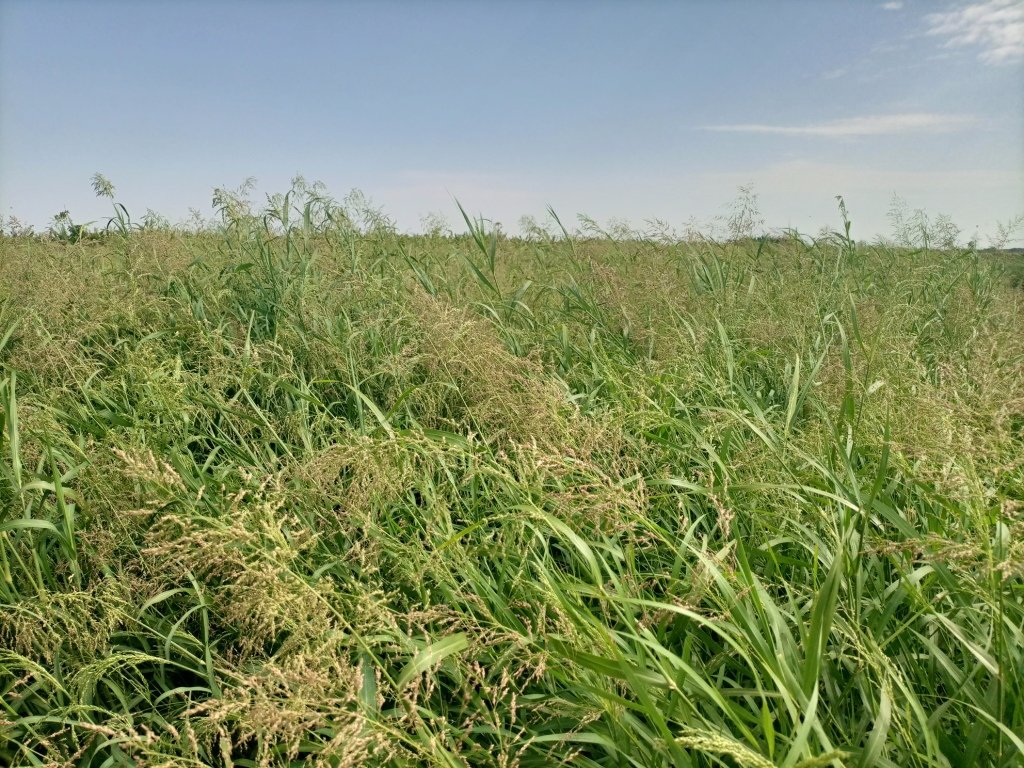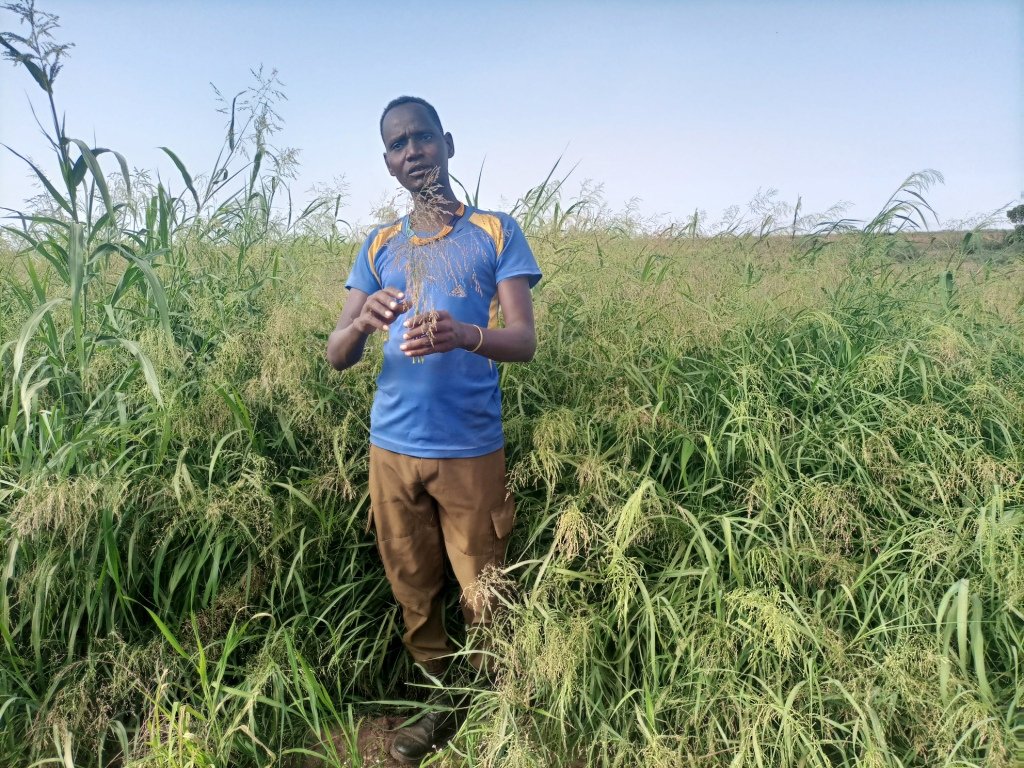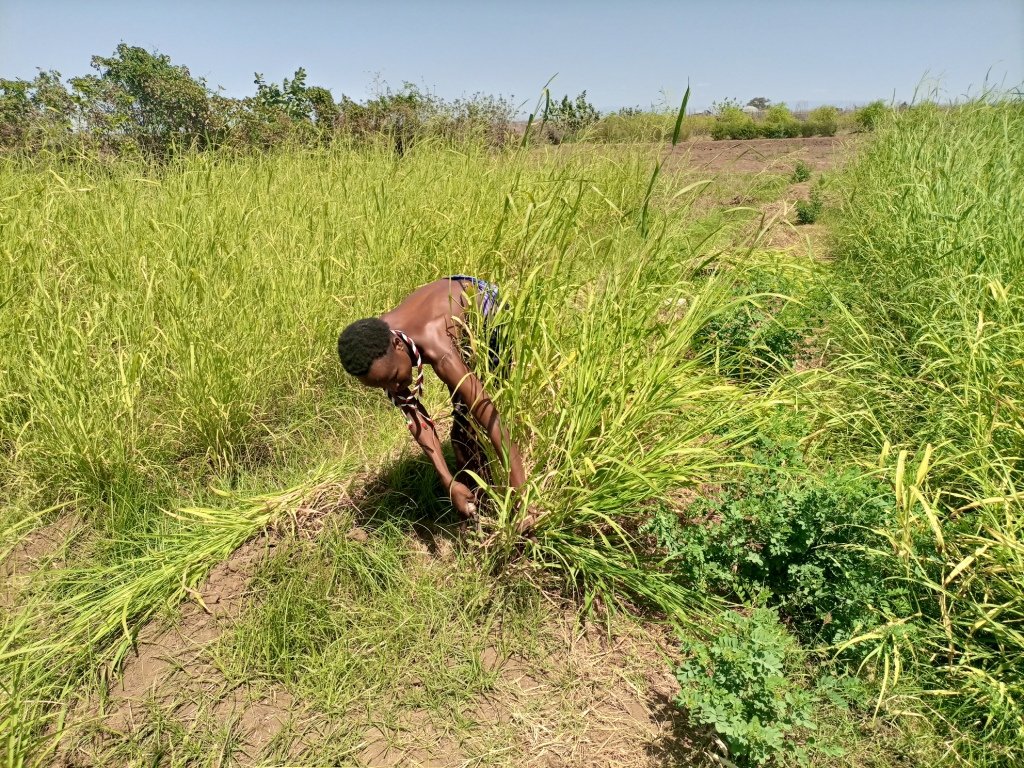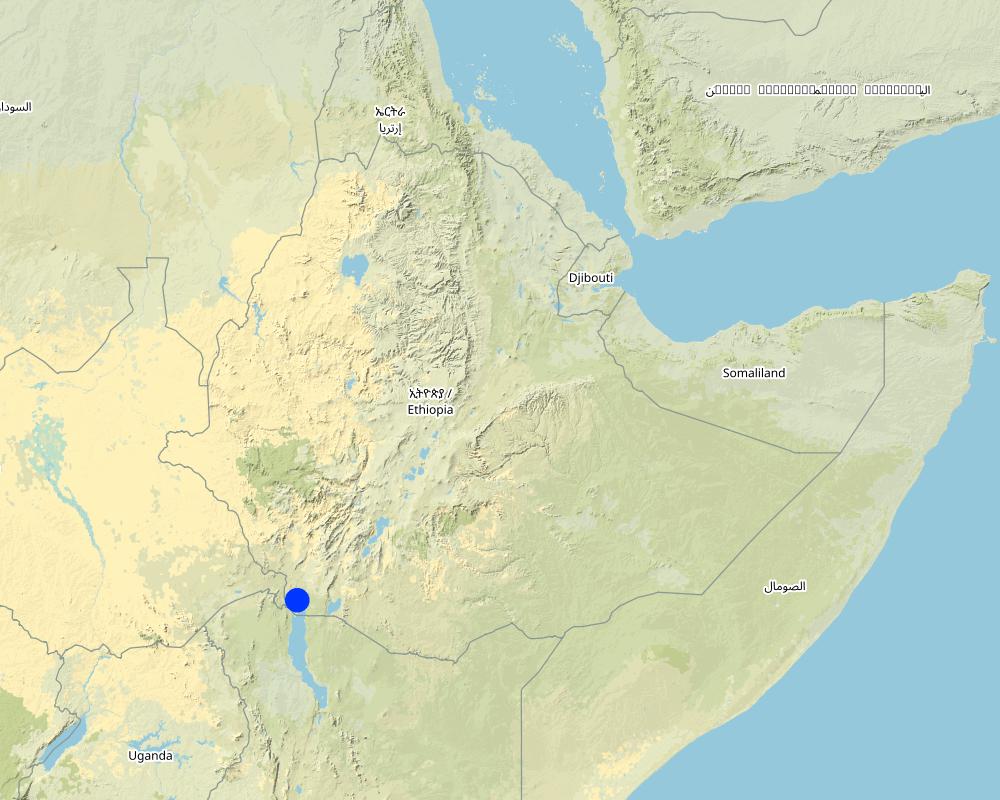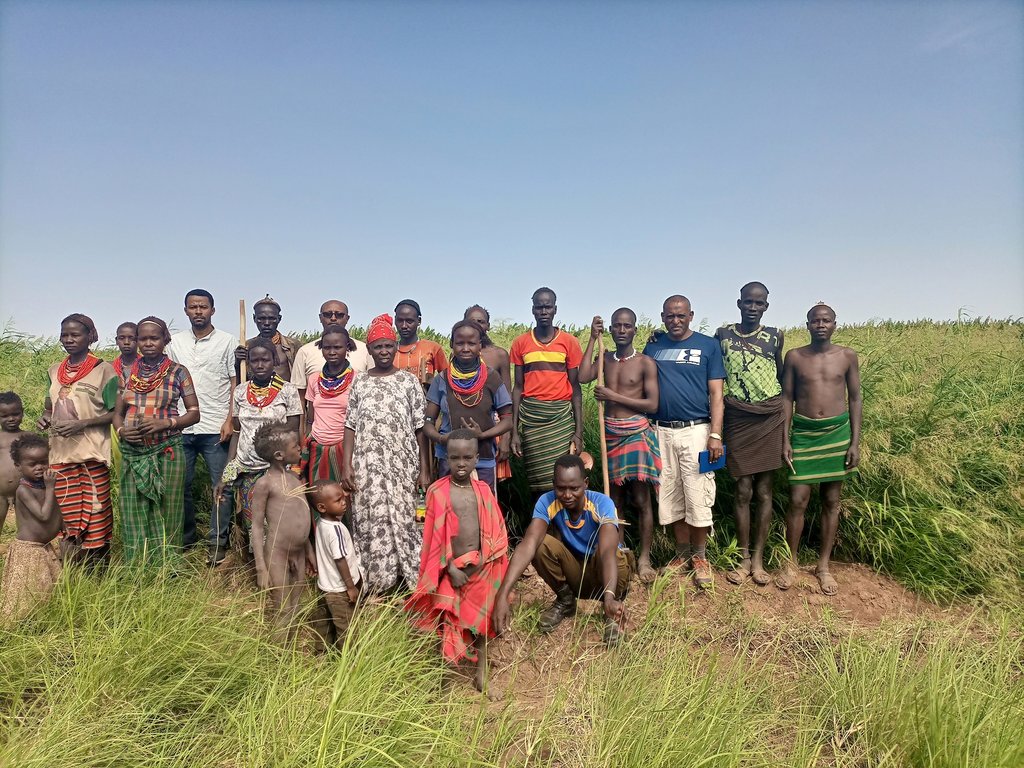Panicum coloratum for irrigated fodder [ប្រទេសអេត្យូពី]
- ការបង្កើត៖
- បច្ចុប្បន្នភាព
- អ្នកចងក្រង៖ GERBA LETA
- អ្នកកែសម្រួល៖ –
- អ្នកត្រួតពិនិត្យច្រើនទៀត៖ William Critchley, Rima Mekdaschi Studer
Panicum
technologies_6563 - ប្រទេសអេត្យូពី
ពិនិត្យមើលគ្រប់ផ្នែក
ពង្រីកមើលទាំងអស់ បង្រួមទាំងអស់1. ព័ត៌មានទូទៅ
1.2 ព័ត៌មានលម្អិតពីបុគ្គលសំខាន់ៗ និងស្ថាប័នដែលចូលរួមក្នុងការវាយតម្លៃ និងចងក្រងឯកសារនៃបច្ចេកទេស
បុគ្គលសំខាន់ម្នាក់ (ច្រើននាក់)
អ្នកប្រើប្រាស់ដី:
Lutulya Abebe
Agro-pastoralist (fodder producers group leader)
ប្រទេសអេត្យូពី
ឈ្មោះគម្រោងដែលបានចងក្រងឯកសារ/ វាយតម្លៃលើបច្ចេកទេស (បើទាក់ទង)
Resilient in Pastoralist Areas (RIPA)ឈ្មោះអង្គភាពមួយ (ច្រើន) ដែលបានចងក្រងឯកសារ/ វាយតម្លៃបច្ចេកទេស (បើទាក់ទង)
International Development Enterprises - Ethiopia (iDE-Ethiopia) - សហរដ្ឋអាមេរិក1.3 លក្ខខណ្ឌទាក់ទងទៅនឹងការប្រើប្រាស់ទិន្នន័យដែលបានចងក្រងតាមរយៈ វ៉ូខេត
អ្នកចងក្រង និង(បុគ្គលសំខាន់ៗ)យល់ព្រមទទួលយកនូវលក្ខខណ្ឌនានាទាក់ទងទៅនឹងការប្រើប្រាស់ទិន្នន័យដែលបានចងក្រងតាមរយៈវ៉ូខេត:
បាទ/ចា៎
1.4 សេចក្តីប្រកាសស្តីពីចីរភាពនៃការពណ៌នាពីបច្ចេកទេស
តើបច្ចេកទេសដែលបានពណ៌នានេះមានបញ្ហាដែលផ្តោតលើការធ្លាក់ចុះគុណភាពដី, បើដូច្នេះវាមិនអាចត្រូវបានប្រកាសថាជាបច្ចេកទេសនៃការគ្រប់គ្រងប្រកបដោយចីរភាពទេ?
ទេ
មតិយោបល់:
The technology is a regenerative practice friendly to the environment.
2. ការពណ៌នាពីបច្ចេកទេស SLM
2.1 ការពណ៌នាដោយសង្ខេបពីបច្ចេកទេស
និយមន័យបច្ចេកទេស:
Panicum coloratum is a palatable tropical grass with high biomass production potential. It is grown in the irrigated fodder development areas of Dassenech district. Panicum is a fast-growing perennial which can be repeatedly harvested once it reaches maturity. It mitigates the issues of recurrent livestock feed shortage in dry periods – which are becoming worse with climate change.
2.2 ការពណ៌នាលម្អិតពីបច្ចេកទេស
ការពណ៌នា:
Irrigated fodder production is carried out by pastoralist groups in arid areas of South Omo. Among a number of fodder grasses, Panicum coloratum is a fast-growing species. Panicum is grown as livestock fodder, particularly for the dry season when feed availability is in short supply. It mitigates the issues of recurrent livestock feed shortages which are becoming worse with climate change. Also, growing fodder grass allows resource-poor pastoralist communities to generate income from the sale of fresh fodder, hay, and seed. Irrigating at least twice a week, good weed management, and fertilization ensure sustained production.
In Dassenech district of Southwest Ethiopia, Panicum’s annual fresh biomass and dry matter production potential is over 63 and 18 tons/ha, respectively. It can reach its first harvest after about 60 days and subsequently can be harvested every 45 days. Panicum germinates and establishes readily on any soil type under both irrigated and rainfed conditions. It is also drought tolerant and resilient to climate variability, and does particularly well on alluvial soils with high fertility. Panicum is mainly used for grazing, but it is also suitable for cut-and-carry feeding systems. Each member of the pastoralist group grows panicum on 0.04 ha of land. In the flood lowlands of the Omo River basin, panicum is known for tolerating periodic flooding, salinity, & disease.
Previously, the land users were unfamiliar with this particular grass and its associated management practices. Also, irrigating on a regular schedule and keeping the grass free from roaming animals adds a work burden to the pastoralist community. However, the Resilience in Pastoral Areas (RIPA) project has introduced and familiarized the community with fodder production and management practices. The project also assists in linking the output to sustainable market. In this regard, the contribution of the RIPA project of the International Development Enterprises (iDE) is immense. The pastoralists appreciate their livestock’s access to year-round feed, as well as the generation of income from the sale of fresh fodder, hay, and seed. Fodder production also creates year-round employment opportunity. However, the community's reliance on government and civic organization support for land preparation and access to irrigation water (conveyance services) might be considered a threat to ensuring sustainability of fodder development by the pastoralist groups.
2.3 រូបភាពនៃបច្ចេកទេស
កំណត់សម្គាល់ទូទៅនៃរូបថត/រូភាព:
The photos display panicum seed and feed harvesting.
2.4 វីដេអូនៃបច្ចេកទេស
ការពណ៌នាសង្ខេប:
Videos of the technology is not documented.
2.5 ប្រទេស/តំបន់/ទីតាំងកន្លែង ដែលបច្ចេកទេសត្រូវបានអនុវត្ត និងបានគ្រប់ដណ្តប់ដោយការវាយតម្លៃនេះ
ប្រទេស:
ប្រទេសអេត្យូពី
តំបន់/រដ្ឋ/ខេត្ត:
Southern Nations, Nationalities and People Region (SNNPR).
បញ្ជាក់បន្ថែមពីលក្ខណៈនៃទីតាំង:
Omorate, Dassenech.
បញ្ជាក់ពីការសាយភាយនៃបច្ចេកទេស:
- អនុវត្តនៅកន្លែងជាក់លាក់មួយ/ ប្រមូលផ្តុំនៅតំបន់តូចៗ
តើបច្ចេកទេស (មួយ ឬច្រើន) ទាំងនោះស្ថិតនៅក្នុងតំបន់ការពារជាអចិន្ត្រៃយ៍ណាមួយដែរឬទេ?
ទេ
មតិយោបល់:
Panicum production site is closer to the mouth of the Omo river. The technology is piloted in two sites and scaling up sites have been increasing around the irrigable areas.
Map
×2.6 កាលបរិច្ឆេទនៃការអនុវត្ត
បង្ហាញឆ្នាំនៃការចុះអនុវត្ត:
2021
2.7 ការណែនាំពីបច្ចេកទេស
សូមបញ្ជាក់តើបច្ចេកទេសត្រូវបានណែនាំឱ្យអនុវត្តដោយរបៀបណា:
- តាមរយៈគម្រោង / អន្តរាគមន៍ពីខាងក្រៅ
មតិយោបល់ (ប្រភេទនៃគម្រោង ។ល។):
Resilient Initiatives in Pastoralist Areas project of the International Development Enterprises has implemented fodder development along with other perennial crops such as banana as part of promoting resilient agriculture in the dry areas of South Omo Zone of SNNPRS.
3. ចំណាត់ថ្នាក់នៃបច្ចេកទេស SLM
3.1 គោលបំណងចម្បង (១ ឬច្រើន) នៃបច្ចេកទេសនេះ
- ធ្វើឱ្យប្រសើរឡើងនូវផលិតកម្ម
- កាត់បន្ថយ, បង្ការ, ស្តារឡើងវិញនូវការធ្លាក់ចុះគុណភាពដី
- កាត់បន្ថយហានិភ័យនៃគ្រោះមហន្តរាយ
- បន្ស៊ាំទៅនឹងការប្រែប្រួលអាកាសធាតុ/គ្រោះមហន្តរាយ និងផលប៉ះពាល់របស់វា
- បង្កើតផលប្រយោជន៍សេដ្ឋកិច្ច
3.2 ប្រភេទដីប្រើប្រាស់មួយប្រភេទ (ច្រើនប្រភេទ) ដែលបានអនុវត្តបច្ចេកទេស
ដីប្រើប្រាស់ចម្រុះនៅលើដីតែមួយ:
ទេ

ដីដាំដំណាំ
- ដំណាំរយៈពេលវែង (មិនមែនឈើ)
ដំណាំរយៈពេលវែង (មិនមែនឈើ) - បញ្ជាក់ប្រភេទដំណាំ:
- ចេក/plantain/abaca
- herbs, chili, capsicum
- natural grasses
ចំនួនសារដែលដាំដំណាំក្នុងមួយឆ្នាំ:
- 2
សូមបញ្ជាក់:
The area receive bimodal rainfall but not reliable to grow crops.
តើជាការអនុវត្តន៍ដំណាំចន្លោះ?
ទេ
តើជាការអនុវត្តន៍ដំណាំវិលជុំ?
ទេ

ដីសម្រាប់ចិញ្ចឹមសត្វ
វាលស្មៅធំៗ:
- ពាក់កណ្តាលពនេចរ
ប្រភេទសត្វ:
- សត្វអូដ្ធ
- cattle - dairy and beef (e.g. zebu)
- សត្វពពែ
- សត្វចៀម
តើជាការអនុវត្តការគ្រប់គ្រងដែលរួមបញ្ចូលការដាំដំណាំ និងចិញ្ចឹមសត្វដែរឬទេ?
ទេ
ផលិតផល និងសេវាកម្ម:
- economic security, investment prestige
- ទឹកដោះគោ
- ស្បែក
ប្រភេទពូជ:
សត្វពពែ
ចំនួន:
12
ប្រភេទពូជ:
cattle - dairy and beef (e.g. zebu)
ចំនួន:
8
ប្រភេទពូជ:
សត្វអូដ្ធ
ចំនួន:
1
ប្រភេទពូជ:
សត្វចៀម
ចំនួន:
9
មតិយោបល់:
The site is pastoralist area who used to rely on flood retreat agriculture in the past. However, due to the construction of Gibe III hydroelectric power dam, the spill over during plenty of rain remain still as artificial lake over thousands of hectare for long period of time. As a result, the conventional agriculture practices abandoned. Thus, a shift to irrigation agriculture is in the process at least to produce fodder crops and other perennial crops such as banana for consumption and market.
3.3 បន្ទាប់ពីអនុវត្តបច្ចេកទេស តើដីប្រើប្រាស់មានការប្រែប្រួលដែររឺទេ?
បន្ទាប់ពីអនុវត្តបច្ចេកទេស តើដីប្រើប្រាស់មានការប្រែប្រួលដែររឺទេ?
- បាទ/ច៎ា (សូមបំពេញសំណួរខាងក្រោមពីស្ថានភាពដីប្រើប្រាស់មុនពេលអនុវត្តបច្ចេកទេស)
ដីប្រើប្រាស់ចម្រុះនៅលើដីតែមួយ:
ទេ

ដីដាំដំណាំ
- ដំណាំរយៈពេលវែង (មិនមែនឈើ)
ដំណាំរយៈពេលវែង (មិនមែនឈើ) - បញ្ជាក់ប្រភេទដំណាំ:
- ចេក/plantain/abaca
- herbs, chili, capsicum
តើជាការអនុវត្តន៍ដំណាំចន្លោះ?
ទេ
តើជាការអនុវត្តន៍ដំណាំវិលជុំ?
ទេ

ដីសម្រាប់ចិញ្ចឹមសត្វ
ដីវាលស្មៅតូចៗ/ ផលិតកម្មចំណី:
- កាត់ និងជញ្ជូន/ គ្មានវាលស្មៅសម្រាប់ចិញ្ចឹមសត្វ
- បង្កើនវាលស្មៅ
មតិយោបល់:
The area used to receive short rain twice a year. However, rainfall distribution is unreliable. So, the introduced perennial fodder and banana production persist throughout the year using irrigation.
3.4 ការផ្គត់ផ្គង់ទឹក
ការផ្គត់ផ្គង់ទឹកនៅកន្លែងអនុវត្តបច្ចេកទេស:
- ប្រព័ន្ធស្រោចស្រពទាំងស្រុង
មតិយោបល់:
Fodder and tropical fruit crop production is entirely practiced using full irrigation from Omo river.
3.5 ក្រុម SLM ដែលបច្ចេកទេសស្ថិតនៅក្នុង
- កសិរុក្ខកម្ម (pastoralism) និងការគ្រប់គ្រងដីសម្រាប់ចិញ្ចឹមសត្វ
- ធ្វើឱ្យប្រសើរឡើងគម្របដី/ ដំណាំគម្របដី
- កាត់បន្ថយការរំខានដល់ដី
3.6 វិធានការ SLM ដែលបញ្ចូលនូវបច្ចេកទេស

វិធានការរុក្ខជាតិ
- V2: ស្មៅនិងរុក្ខជាតិៗដែលដុះមានអាយុមិនលើសពី 2ឆ្នាំ
មតិយោបល់:
Perennial fodder production contributes to SLM through permanent soil cover.
3.7 កំណត់ប្រភេទនៃការធ្លាក់ចុះគុណភាពដីសំខាន់ៗដែលបច្ចេកទេសនេះបានដោះស្រាយ

ការបាត់ដីដោយសារខ្យល់
- Ed: អតិផរណា និង ការទម្លាក់

ការធ្លាក់ចុះសារធាតុគីមីក្នុងដី
- Cs: សារធាតុប្រៃ/អាល់កាឡាំង

ការបាត់បង់ទឹក
- Ha: ការថយចុះសំណើមដី
មតិយោបល់:
As a perennial crop, the grass covers the ground permanently and reduces moisture loss to excessive evaporation in the dry areas.
3.8 ការពារ កាត់បន្ថយ ឬស្តារឡើងវិញនៃការធ្លាក់ចុះគុណភាពដី
បញ្ជាក់ពីគោលដៅរបស់បច្ចេកទេស ដែលផ្តោតទៅការធ្លាក់ចុះគុណភាពដី:
- ការការពារការធ្លាក់ចុះគុណភាពដី
4. បច្ចេកទេសជាក់លាក់ សកម្មភាពអនុវត្ត ធាតុចូល និងថ្លៃដើម
4.1 គំនូសបច្ចេកទេសនៃបច្ចេកទេសនេះ
លក្ខណៈពិសេសនៃបច្ចេកទេស (ទាក់ទងនឺងគំនូរបច្ចេកទេស):
This is the photo of the pastoralist group. There is no specific sketching that portrays the technology but the following points provide tips for adopters of the technology:
- The land is tilled and harrowed by a tractor for two to three rounds.
- On the third-round ridge and furrow are formed using tractor or hand tools.
- The seeds or splits are planted in rows along the ridge.
- Spacing between ridges varies with the purpose: for haymaking 25 -30 cm and for seed production 50-60 cm to simplify the application of intensive management practice for the latter one.
- The farm/crop should be irrigated twice a week for better production.
- Need Fertilization to ensure good production/harvest.
ឈ្មោះអ្នកនិពន្ធ:
Gerba Leta
កាលបរិច្ឆេទ:
19/08/2022
4.2 ព័ត៌មានទូទៅដែលពាក់ព័ន្ធនឹងការគណនាធាតុចូល និងថ្លៃដើម
កំណត់របៀបនៃការគណនាថ្លៃដើម និងធាតុចូល:
- ក្នុងតំបន់អនុវត្តបច្ចេកទេស
កំណត់ទំហំ និងឯកត្តាផ្ទៃដី:
1 timad
បើសិនប្រើឯកតាតាមតំបន់ សូមបញ្ជាក់តម្លៃបម្លែងវាទៅជាហិកតា (ឧ. 1 ហិកតា = 2.47 អា)៖ 1 ហិកតា =:
0.25 ha
ផ្សេងៗ/ រូបិយប័ណ្ណជាតិ (បញ្ជាក់):
Ethiopian Birr (ETB)
បើពាក់ព័ន្ធសូមកំណត់អត្រាប្តូរប្រាក់ពីដុល្លាទៅរូបិយប័ណ្ណតំបន់ (ឧ. 1 ដុល្លារ = 79.9 រៀលនៃរូបិយប័ណ្ណប្រេស៊ីល) ៖ 1 ដុល្លារ =:
53,438
កំណត់ថ្លៃឈ្នួលជាមធ្យមនៃការជួលកម្លាំងពលកម្មក្នុងមួយថ្ងៃ:
It is variable based on the types of work (from 50 birr to 100) for half day before the sun gets too hot. That is equivalent to one day in dry lowland areas.
4.3 សកម្មភាពបង្កើត
| សកម្មភាព | រយៈពេល (រដូវកាល) | |
|---|---|---|
| 1. | Clearing and land preparation | Any season for irrigated fodder production, |
| 2. | Planting/sowing | During the start of season for irrigation fodder production. |
| 3. | Fertilizing | At planting and at boot height. |
| 4. | Irrigating the farm | Twice a week. |
| 5. | Weeding | Twice starting 3- 4 weeks post planting. |
| 6. | Harvesting the grass (fodder) | During harvest maturity. |
| 7. | Hay making (bailing) | Post harvest. |
| 8. | Seed collection, drying and cleaning | Harvesting season and post harvest. |
មតិយោបល់:
As fodder development is based on irrigation, it can be started any time/season of the year.
4.4 ថ្លៃដើម និងធាតុចូលដែលត្រូវការសម្រាប់ការបង្កើតបច្ចេកទេស
| បញ្ជាក់ពីធាតុចូល | ឯកតា | បរិមាណ | ថ្លៃដើមក្នុងមួយឯកតា | ថ្លៃធាតុចូលសរុប | % នៃថ្លៃដើមដែលចំណាយដោយអ្នកប្រើប្រាស់ដី | |
|---|---|---|---|---|---|---|
| កម្លាំងពលកម្ម | Clearing and land preparation | PDs | 12,0 | 200,0 | 2400,0 | 50,0 |
| កម្លាំងពលកម្ម | Planting/sowing | PDs | 5,0 | 100,0 | 500,0 | 100,0 |
| កម្លាំងពលកម្ម | Irrigating the farm | PDs | 14,0 | 200,0 | 2800,0 | 100,0 |
| កម្លាំងពលកម្ម | Weeding (twice a season) | PDs | 10,0 | 100,0 | 1000,0 | 100,0 |
| សម្ភារៈ | Spade | Pcs | 1,0 | 500,0 | 500,0 | |
| សម្ភារៈ | Hoes | Pcs | 1,0 | 300,0 | 300,0 | |
| សម្ភារៈដាំដុះ | Seed | kg | 4,0 | 300,0 | 1200,0 | |
| ជី និងសារធាតុពុល | NSP | kg | 50,0 | 50,0 | 2500,0 | |
| ផ្សេងៗ | Seed collection, drying and cleaning | PDs | 10,0 | 200,0 | 2000,0 | 100,0 |
| ផ្សេងៗ | Harvesting and hay making | PDs | 10,0 | 200,0 | 2000,0 | 100,0 |
| ថ្លៃដើមសរុបក្នុងការបង្កើតបច្ចេកទេស | 15200,0 | |||||
| ថ្លៃដើមសរុបក្នុងការបង្កើតបច្ចេកទេសគិតជាដុល្លារ | 284,44 | |||||
ប្រសិនបើអ្នកប្រើប្រាស់ដីមិនមានថ្លៃដើម 100% សូមបញ្ជាក់ថានរណាដែលចំណាយថ្លៃដើមដែលនៅសល់:
Other than cost of labor, some inputs and material costs are covered by the RIPA project of the iDE.
មតិយោបល់:
Irrigation-based fodder development is in the pilot phase. There is growing interest among the government organization (Woreda Office of Agriculture) to adopt and scale up the promising development. Please note, the cost is estimated only for a season or one round of production. Once reaches its first harvest, Panicum can be harvested every other 45 days onward. Of course, it needs the application of necessary management practices, every season.
4.5 សកម្មភាពថែទាំ
| សកម្មភាព | ពេលវេលា/ ភាពញឹកញាប់ | |
|---|---|---|
| 1. | Cleaning irrigation ditch | During off-season or before the start of next growing season. |
| 2. | Fertilizer (NSP) | Twice: at the beginning of the season & when the fodder reaches boots height. |
| 3. | Irrigating the farm | Twice a week. |
| 4. | Weeding (2x) | Based on the density or prevalence of weeds. |
| 5. | Seed collection, drying and cleaning | When the seed reaches harvest maturity. |
| 6. | Harvesting and hay making | At harvest and post harvest. |
មតិយោបល់:
As there is no structure such as fodder banks, maintenance cost is not documented.
4.6 កំណត់ថ្លៃដើមសម្រាប់ការថែទាំ/ សកម្មភាពរបស់បច្ចេកទេស (ក្នុងរយៈពេលមួយឆ្នាំ)
| បញ្ជាក់ពីធាតុចូល | ឯកតា | បរិមាណ | ថ្លៃដើមក្នុងមួយឯកតា | ថ្លៃធាតុចូលសរុប | % នៃថ្លៃដើមដែលចំណាយដោយអ្នកប្រើប្រាស់ដី | |
|---|---|---|---|---|---|---|
| កម្លាំងពលកម្ម | Cleaning irrigation ditch | PDs | 5,0 | 200,0 | 1000,0 | 100,0 |
| កម្លាំងពលកម្ម | Irrigating the farm | PDs | 12,0 | 200,0 | 2400,0 | 100,0 |
| កម្លាំងពលកម្ម | Weeding (at least twice during the growing season) | PDs | 10,0 | 100,0 | 1000,0 | 100,0 |
| កម្លាំងពលកម្ម | Seed collection, drying and cleaning | PDs | 10,0 | 200,0 | 2000,0 | 100,0 |
| សម្ភារៈ | Harvesting and hay making | PDs | 10,0 | 200,0 | 2000,0 | 100,0 |
| ជី និងសារធាតុពុល | NSP Fertilizers | kg | 50,0 | 50,0 | 2500,0 | 100,0 |
| ថ្លៃដើមសរុបសម្រាប់ការថែទាំដំណាំតាមបច្ចេកទេស | 10900,0 | |||||
| ថ្លៃដើមសរុបសម្រាប់ការថែទាំដំណាំតាមបច្ចេកទេសគិតជាដុល្លារ | 203,97 | |||||
ប្រសិនបើអ្នកប្រើប្រាស់ដីមិនមានថ្លៃដើម 100% សូមបញ្ជាក់ថានរណាដែលចំណាយថ្លៃដើមដែលនៅសល់:
NA
មតិយោបល់:
The cost estimation is only for one irrigation season that may range from 45 days to 60 days or some more including the harvesting and drying of the outputs. Once established, the cost of production is gradually declining.
4.7 កត្តាសំខាន់បំផុតដែលមានឥទ្ធិពលដល់ការចំណាយ
ពណ៌នាពីកត្តាប៉ះពាល់ចម្បងៗទៅលើថ្លៃដើម:
Economic crisis and increasing Inflation rate affect the establishment as well as maintenance costs. Particularly, fuel, fertilizer, and labor costs are consistently changing.
5. លក្ខណៈបរិស្ថានធម្មជាតិ និងមនុស្ស
5.1 អាកាសធាតុ
បរិមាណទឹកភ្លៀងប្រចាំឆ្នាំ
- < 250 មម
- 251-500 មម
- 501-750 មម
- 751-1,000 មម
- 1,001-1,500 មម
- 1,501-2,000 មម
- 2,001-3,000 មម
- 3,001-4,000 មម
- > 4,000 មម
លក្ខណៈពិសេស/ មតិយោបល់លើរដូវភ្លៀង:
Erratic and unpredictable.
តំបន់កសិអាកាសធាតុ
- មានភ្លៀងតិចតួច
Rainfall distribution is unreliable to produce crops under rainfed conditions.
5.2 សណ្ឋានដី
ជម្រាលជាមធ្យម:
- រាបស្មើ (0-2%)
- ជម្រាលតិចតួច (3-5%)
- មធ្យម (6-10%)
- ជម្រាលខ្ពស់បន្តិច (11-15%)
- ទីទួល (16-30%)
- ទីទួលចោត (31-60%)
- ទីទួលចោតខ្លាំង (>60%)
ទម្រង់ដី:
- ខ្ពង់រាប
- កំពូលភ្នំ
- ជម្រាលភ្នំ
- ជម្រាលទួល
- ជម្រាលជើងភ្នំ
- បាតជ្រលងភ្នំ
តំបន់តាមរយៈកម្ពស់ :
- 0-100 ម
- 101-500 ម
- 501-1,000 ម
- 1,001-1,500 ម
- 1,501-2,000 ម
- 2,001-2,500 ម
- 2,501-3,000 ម
- 3,001-4,000 ម
- > 4,000 ម
បញ្ជាក់ថាតើបច្ចេកទេសនេះត្រូវបានអនុវត្តន៍នៅក្នុង:
- មិនពាក់ព័ន្ធទាំងអស់
មតិយោបល់ និងបញ្ចាក់បន្ថែមអំពីសណ្ឋានដី :
The site is in the lowland around the mouth of Omo River basin.
5.3 ដី
ជម្រៅដីជាមធ្យម:
- រាក់ខ្លាំង (0-20 សម)
- រាក់ (21-50 សម)
- មធ្យម (51-80 សម)
- ជ្រៅ (81-120 សម)
- ជ្រៅខ្លាំង (> 120 សម)
វាយនភាពដី (ស្រទាប់លើ):
- មធ្យម (ល្បាយ, ល្បាប់)
វាយនភាពដី (> 20 សម ស្រទាប់ក្នុង):
- មធ្យម (ល្បាយ, ល្បាប់)
សារធាតុសរីរាង្គនៅស្រទាប់ដីខាងលើ:
- មធ្យម (1-3%)
បើអាចសូមភ្ជាប់ការពណ៌នាពីដីឱ្យបានច្បាស់ ឬព័ត៌មានដែលអាចទទួលបាន ឧ. ប្រភេទដី, pH ដី/ ជាតិអាស៊ីត, សមត្ថភាពផ្លាស់ប្តូរកាចុង, វត្តមាននីត្រូសែន, ភាពប្រៃ ។ល។:
Soil pH is over 7 and the soil is slightly saline alluvial.
5.4 ទឹកដែលអាចទាញមកប្រើប្រាស់បាន និងគុណភាពទឹក
នីវ៉ូទឹកក្រោមដី:
> 50 ម
ទឹកលើដីដែលអាចទាញយកប្រើប្រាស់បាន:
មិនមាន/ គ្មាន
គុណភាពទឹក (មិនបានធ្វើប្រត្តិកម្ម):
ទឹកសម្រាប់តែការធ្វើកសិកម្ម (ស្រោចស្រព)
គុណភាពទឹក គឺផ្តោតទៅលើ៖:
ទឹកលើផ្ទៃដី
តើមានបញ្ហាភាពទឹកប្រៃហូរចូលមកដែរឬទេ?
ទេ
តើទឹកជំនន់កំពុងកើតមាននៅតំបន់នេះដែររឺទេ?
បាទ/ចា៎
ភាពទៀងទាត់:
ម្តងម្កាល
មតិយោបល់ និងលក្ខណៈពិសេសផ្សេងៗទៀតលើគុណភាព និងបរិមាណទឹក :
Diversion/river water is used for irrigation. There is ample water provide that there is pump to convey the water to the nearby farm. In the rainy season, the river is turbid and full of eroded soil from the upstream catchments. However, the depth of the water table is variable based on the distance of the farm from the edge of the river. Around the main river basin, the water table is shallow but too deep as one go away from the river basin.
5.5 ជីវៈចម្រុះ
ភាពសម្បូរបែបនៃប្រភេទ:
- ទាប
ភាពសម្បូរបែបនៃទីជម្រក:
- ទាប
មតិយោបល់ និងលក្ខណៈពិសេសផ្សេងទៀតលើជីវចម្រុះ:
Around the farmland, diversity of crops and vegetation is limited. Away from the farmland, there are a few lowland shrub species and faunas common to the dryland.
5.6 លក្ខណៈនៃអ្នកប្រើប្រាស់ដីដែលអនុវត្តបច្ចេកទេស
នៅមួយកន្លែង ឬពនេចរ :
- ពាក់កណ្តាលពនេចរ
ទីផ្សារនៃប្រព័ន្ធផលិតកម្ម:
- សម្រាប់ហូបក្នុងគ្រួសារ (ផ្គត់ផ្គង់ខ្លួនឯង)
ចំណូលក្រៅកសិកម្ម:
- តិចជាង 10% នៃចំណូល
កម្រិតជីវភាព:
- មិនល្អ
ឯកជន ឬក្រុម:
- ជាក្រុម/ សហគមន៍
កម្រិតប្រើប្រាស់គ្រឿងយន្ត:
- ប្រើកម្លាំងពលកម្ម
- គ្រឿងយន្ត/ ម៉ាស៊ីន
យេនឌ័រ:
- បុរស
អាយុរបស់អ្នកប្រើប្រាស់ដី:
- វ័យកណ្តាល
សូមបញ្ជាក់ពីលក្ខណៈពាក់ព័ន្ធផ្សេងទៀតអំពីអ្នកប្រើប្រាស់ដី:
The water pump is used to convey water and the tractor for land preparation. Therefore, a mix of mechanization and manual systems are employed in the area. Irrigation land was allocated to the group but they partitioned and distributed to each member of the group.
5.7 ទំហំផ្ទៃដីជាមធ្យមនៃដីប្រើប្រាស់ដោយអ្នកប្រើប្រាស់ដី ក្នុងការអនុវត្តបច្ចេកទេស
- < 0.5 ហិកតា
- 0.5-1 ហិកតា
- 1-2 ហិកតា
- 2-5 ហិកតា
- 5-15 ហិកតា
- 15-50 ហិកតា
- 50-100 ហិកតា
- 100-500 ហិកតា
- 500-1,000 ហិកតា
- 1,000-10,000 ហិកតា
- > 10,000 ហិកតា
តើផ្ទៃដីនេះចាត់ទុកជាទំហំកម្រិតណាដែរ ខ្នាតតូច មធ្យម ឬខ្នាតធំ (ធៀបនឹងបរិបទតំបន់)?
- ខ្នាតតូច
មតិយោបល់:
As their animal is freely roaming, only small size of land is permantantly owned around the river side and homestead.
5.8 ភាពជាម្ចាស់ដី កម្មសិទ្ធប្រើប្រាស់ដី និងកម្មសិទ្ធប្រើប្រាស់ទឹក
ភាពជាម្ចាស់ដី:
- ក្រុម
- ឯកជន មិនមានកម្មសិទ្ធ
កម្មសិទ្ធិប្រើប្រាស់ដី:
- ជាក្រុម (មានដែនកំណត់)
- ឯកជន
កម្មសិទ្ធប្រើប្រាស់ទឹក:
- អាស្រ័យផលសេរី (មិនមានការកំណត់)
តើកម្មសិទ្ធប្រើប្រាស់ដី គឺផ្អែកលើប្រព័ន្ធច្បាប់បែបបុរាណ?
បាទ/ចា៎
សូមបញ្ជាក់:
The pastoralist, still freely move and settle where they think appropriate and shift after certain years.
មតិយោបល់:
Apart from the irrigable land which are located around the river basin, land is openly accessible to the pastoralist community.
5.9 ការប្រើប្រាស់សេវាកម្ម និងហេដ្ឋារចនាសម្ព័ន្ធ
សុខភាព:
- មិនល្អ
- មធ្យម
- ល្អ
ការអប់រំ:
- មិនល្អ
- មធ្យម
- ល្អ
ជំនួយបច្ចេកទេស:
- មិនល្អ
- មធ្យម
- ល្អ
ការងារ (ឧ. ការងារក្រៅកសិដ្ឋាន):
- មិនល្អ
- មធ្យម
- ល្អ
ទីផ្សារ:
- មិនល្អ
- មធ្យម
- ល្អ
ថាមពល:
- មិនល្អ
- មធ្យម
- ល្អ
ផ្លូវ និងការដឹកជញ្ជូន:
- មិនល្អ
- មធ្យម
- ល្អ
ទឹកផឹក និងអនាម័យ:
- មិនល្អ
- មធ្យម
- ល្អ
សេវាកម្មហិរញ្ញវត្ថុ:
- មិនល្អ
- មធ្យម
- ល្អ
មតិយោបល់:
Access to facility and the services is mainly to those pastoralist community who are residing closer to the Omorate, the woreda capital.
6. ផលប៉ះពាល់ និងការសន្និដ្ឋាន
6.1 ផលប៉ះពាល់ក្នុងបរិវេណអនុវត្តបច្ចេកទេសដែលកើតមាន
ផលប៉ះពាល់លើសេដ្ឋកិច្ចសង្គម
ផលិតផល
ផលិតកម្មចំណីសត្វ
មតិយោបល់/ ការបញ្ជាក់:
Access to irrigation water increase the fodder production throughout the year.
គុណភាពចំណីសត្វ
មតិយោបល់/ ការបញ្ជាក់:
As the alluvial soil around the river bank is suitable for Panicum, it increases the quality of fodder.
ផលិតកម្មសត្វ
មតិយោបល់/ ការបញ្ជាក់:
Increase in livestock production is related to the availability of feed/fodder.
ហានិភ័យនៃភាពបរាជ័យរបស់ផលិតកម្ម
មតិយោបល់/ ការបញ្ជាក់:
Access to irrigation water highly reduced risk of production failure.
ផ្ទៃដីផលិតកម្ម
គុណភាពមុន SLM:
-1
គុណភាពក្រោយ SLM:
2
មតិយោបល់/ ការបញ្ជាក់:
The land that used to be ideal is now converted to farming.
ការគ្រប់គ្រងដី
មតិយោបល់/ ការបញ្ជាក់:
Panicum as perennial fodder increases ground cover throughout the year and contributes to land management from wind erosion in the dry land areas.
ទឹកដែលអាចទាញមកប្រើប្រាស់បាន និងគុណភាពទឹក
ទឹកបរិភោគដែលអាចទាញយកមកប្រើប្រាស់បាន
គុណភាពមុន SLM:
-3
គុណភាពក្រោយ SLM:
1
ទឹកដែលអាចប្រើប្រាស់បានសម្រាប់ការចិញ្ចឹមសត្វ
គុណភាពមុន SLM:
0
គុណភាពក្រោយ SLM:
0
គុណភាពទឹកសម្រាប់ការចិញ្ចឹមសត្វ
គុណភាពមុន SLM:
0
គុណភាពក្រោយ SLM:
0
ទឹកប្រើប្រាស់សម្រាប់ស្រោចស្រព
គុណភាពមុន SLM:
0
គុណភាពក្រោយ SLM:
0
គុណភាពទឹកស្រោចស្រព
គុណភាពមុន SLM:
0
គុណភាពក្រោយ SLM:
0
តម្រូវការទឹកសម្រាប់ស្រោចស្រព
គុណភាពមុន SLM:
0
គុណភាពក្រោយ SLM:
-1
ចំណូល និងថ្លៃដើម
ចំណូលក្នុងកសិដ្ឋាន
មតិយោបល់/ ការបញ្ជាក់:
As Panicum is harvested at least six times a year post reaching the first maturity, farm income is significantly increases.
ភាពសម្បូរបែបប្រភពប្រាក់ចំណូល
មតិយោបល់/ ការបញ្ជាក់:
Income can be generated from the sale of fresh fodder, hay and seeds.
ភាពខុសគ្នាផ្នែកសេដ្ឋកិច្ច
គុណភាពមុន SLM:
-2
គុណភាពក្រោយ SLM:
0
បន្ទុកការងារ
មតិយោបល់/ ការបញ្ជាក់:
Irrigated fodder production needs intensive management practices. Panicum is perennial fodder that remain on the field all year round. So, irrigating, weeding and looking after the farm... increases the workload.
ផលប៉ះពាល់ទៅលើវប្បធម៌សង្គម
សន្តិសុខស្បៀង/ ភាពគ្រប់គ្រាន់ខ្លួនឯង
គុណភាពមុន SLM:
-1
គុណភាពក្រោយ SLM:
2
ស្ថានភាពសុខភាព
គុណភាពមុន SLM:
-1
គុណភាពក្រោយ SLM:
1
កម្មសិទ្ធដីប្រើប្រាស់/ ទឹក
គុណភាពមុន SLM:
0
គុណភាពក្រោយ SLM:
0
ឱកាសវប្បធម៍
គុណភាពមុន SLM:
0
គុណភាពក្រោយ SLM:
1
ឱកាសនៃការបង្កើតថ្មី
គុណភាពមុន SLM:
0
គុណភាពក្រោយ SLM:
0
ស្ថាប័នសហគមន៍
គុណភាពមុន SLM:
-2
គុណភាពក្រោយ SLM:
2
ស្ថាប័នជាតិ
គុណភាពមុន SLM:
0
គុណភាពក្រោយ SLM:
0
ចំណេះដឹង SLM / ការធ្លាក់ចុះគុណភាពដី
គុណភាពមុន SLM:
-2
គុណភាពក្រោយ SLM:
2
ការកាត់បន្ថយជម្លោះ
គុណភាពមុន SLM:
0
គុណភាពក្រោយ SLM:
2
ស្ថានភាពក្រុមដែលមានបញ្ហាក្នុងសង្គម និងសេដ្ឋកិច្ច
គុណភាពមុន SLM:
-2
គុណភាពក្រោយ SLM:
1
ផលប៉ះពាល់ទៅលើអេកូឡូស៊ី
វដ្តទឹក/លំហូរ
លំហូរទឹកលើផ្ទៃដី
មតិយោបល់/ ការបញ្ជាក់:
As it permanently covers the ground, it has high likelihoods of reducing surface runoff.
ប្រព័ន្ធបង្ហូរទឹក
មតិយោបល់/ ការបញ្ជាក់:
Improve water drainage.
រំហួត
មតិយោបល់/ ការបញ្ជាក់:
Decreases surface evaporation but not transpiration.
ជីវចម្រុះ៖ ដំណាំ, សត្វ
ដំណាំគម្រប
មតិយោបល់/ ការបញ្ជាក់:
The farm remains covered by perennial grass. Irrigating the farm also favor the regrowth of other wild species.
ជីវម៉ាស/ កាបូនលើដី
មតិយោបល់/ ការបញ្ជាក់:
Above ground biomass is highly increased as described in the description section.
ភាពសម្បូរបែបនៃរុក្ខជាតិ
ប្រភេទរាតត្បាត
មតិយោបល់/ ការបញ្ជាក់:
Reduced with increased management practices. Invasive alien species such as Prosopis juliflora is less common in this part of the River basin.
ភាពសម្បូរបែបនៃសត្វ
មតិយោបល់/ ការបញ្ជាក់:
Animal diversity correlates with fodder availability.
ប្រភេទសត្វមានប្រយោជន៍
ភាពសម្បូរបែបនៃទីជំរក
ការគ្រប់គ្រងកត្តាចង្រៃ/ ជំងឺ
ការកាត់បន្ថយហានិភ័យនៃគ្រោះមហន្តរាយ និងគ្រោះអាកាសធាតុ
ផលប៉ះពាល់នៃទឹកជំនន់
ផលប៉ះពាល់នៃគ្រោះរាំងស្ងួត
មតិយោបល់/ ការបញ្ជាក់:
It reduces the impacts of drought on livestock by providing access to adequate feeds throughout the year.
ការបំភាយនៃកាបូន និងឧស្ម័នផ្ទះកញ្ចក់
មតិយោបល់/ ការបញ្ជាក់:
As Panicum increase ground cover and store the carbon above and below the soil surface, it reduces the emission of the carbon.
ល្បឿនខ្យល់
មតិយោបល់/ ការបញ្ជាក់:
It breaks the velocity of wind in the lowland, one of the main issues.
អាកាសធាតុ
មតិយោបល់/ ការបញ្ជាក់:
Slightly ameliorate the micro-climate of the area.
6.2 ផលប៉ះពាល់ក្រៅបរិវេណអនុវត្តបច្ចេកទេសដែលកើតមាន
ទឹកដែលអាចទាញមកប្រើប្រាស់បាន
គុណភាពមុន SLM:
0
គុណភាពក្រោយ SLM:
0
លំហូរទឹកដែលអាចប្រើប្រាស់បាននៅរដូវប្រាំង
គុណភាពមុន SLM:
0
គុណភាពក្រោយ SLM:
0
ទឹកជំនន់ខ្សែទឹកខាងក្រោម
មតិយោបល់/ ការបញ្ជាក់:
It is expected that downstream flooding is reduced as the perennial fodder crop cover the ground throughout the year.
កំណកល្បាប់ខ្សែទឹកខាងក្រោម
គុណភាពមុន SLM:
-3
គុណភាពក្រោយ SLM:
0
ទឹកក្រោមដី/ ការបំពុលទឹកទន្លេ
គុណភាពមុន SLM:
-1
គុណភាពក្រោយ SLM:
0
Buffering/សមត្ថភាពចម្រោះ
មតិយោបល់/ ការបញ្ជាក់:
Permanent ground cover expected to increase the filtering capacity.
ខ្យល់នាំយកនូវធូរលី
មតិយោបល់/ ការបញ្ជាក់:
It has expected positive effects of reducing wind transportation.
ខូចខាតដល់ស្រែអ្នកជិតខាង
ខូចខាតដល់ហេដ្ឋារចនាសម្ព័ន្ធសាធារណៈ/ឯកជន
ផលប៉ះពាល់នៃឧស្ម័នផ្ទះកញ្ចក់
មតិយោបល់/ ការបញ្ជាក់:
As perennial crops cover the ground and absorb the carbon, it has an inevitable positive effects on reducing carbon emission.
វាយតម្លៃផលប៉ះពាល់ក្រៅបរិវេណអនុវត្តបច្ចេកទេស (វាស់វែង):
The fodder development is a pilot practice. Its up scaling will have a positive off-site effects to the surrounding areas.
6.3 ភាពប្រឈម និងភាពរួសនៃបច្ចេកទេសទៅនឹងការប្រែប្រួលអាកាសធាតុ និងគ្រោះអាកាសធាតុ/ គ្រោះមហន្តរាយ (ដែលដឹងដោយអ្នកប្រើប្រាស់ដី)
ការប្រែប្រួលអាកាសធាតុ
ការប្រែប្រួលអាកាសធាតុ
| រដូវកាល | កើនឡើង ឬថយចុះ | លក្ខណៈឆ្លើយតបនៃបច្ចេកទេសទៅនឹងការប្រែប្រួលអាកាសធាតុ | |
|---|---|---|---|
| សីតុណ្ហភាពប្រចាំឆ្នាំ | កើនឡើង | មធ្យម | |
| បរិមាណទឹកភ្លៀងប្រចាំឆ្នាំ | ថយចុះ | ល្អ |
គ្រោះអាកាសធាតុ (មហន្តរាយ)
គ្រោះមហន្តរាយធម្មជាតិ
| លក្ខណៈឆ្លើយតបនៃបច្ចេកទេសទៅនឹងការប្រែប្រួលអាកាសធាតុ | |
|---|---|
| ព្យុះកំបុតត្បូងតាមតំបន់ | មធ្យម |
គ្រោះមហន្តរាយអាកាសធាតុ
| លក្ខណៈឆ្លើយតបនៃបច្ចេកទេសទៅនឹងការប្រែប្រួលអាកាសធាតុ | |
|---|---|
| រលកកម្តៅ | មធ្យម |
| រាំងស្ងួត | ល្អ |
គ្រោះមហន្តរាយទឹក
| លក្ខណៈឆ្លើយតបនៃបច្ចេកទេសទៅនឹងការប្រែប្រួលអាកាសធាតុ | |
|---|---|
| ទឹកជំនន់ទូទៅ (ទន្លេ) | ល្អណាស់ |
| ទឹកជំនន់ដោយទឹកភ្លៀង | ល្អ |
គ្រោះមហន្តរាយជីវៈសាស្ត្រ
| លក្ខណៈឆ្លើយតបនៃបច្ចេកទេសទៅនឹងការប្រែប្រួលអាកាសធាតុ | |
|---|---|
| ការរាតត្បាតនៃជំងឺ | ល្អ |
| ការមានបញ្ហាសត្វល្អិត/ដង្កូវ | ល្អ |
មតិយោបល់:
Panicum has drought, flood and disease tolerating feature.
6.4 ការវិភាគថ្លៃដើម និងអត្ថប្រយោជន៍
តើផលចំណេញ និងថ្លៃដើមត្រូវបានប្រៀបធៀបគ្នាយ៉ាងដូចម្តេច (ទស្សនៈរបស់អ្នកប្រើប្រាស់ដី)?
រយៈពេលខ្លី:
វិជ្ជមានតិចតួច
រយៈពេលវែង:
វិជ្ជមាន
តើផលចំណេញ និងការថែទាំ/ ជួសជុលត្រូវបានប្រៀបធៀបគ្នាយ៉ាងដូចម្តេច (ទស្សនៈរបស់អ្នកប្រើប្រាស់ដី)?
រយៈពេលខ្លី:
វិជ្ជមាន
រយៈពេលវែង:
វិជ្ជមានខ្លាំង
មតិយោបល់:
The technology was piloted two years ago. The cost of establishing it is partly supported by the RIPA project. Land preparation and conveying irrigation water covered by the local government.
6.5 ការទទួលយកបច្ចេកទេស
- តែមួយករណី /ពិសោធន៍
មតិយោបល់:
So far, the pastoralist piloted the technology through government and NGO support.
6.6 ការបន្សុំា
តើថ្មីៗនេះ បច្ចេកទេសនេះត្រូវបានកែតម្រូវដើម្បីបន្ស៊ាំទៅនឹងស្ថានភាពប្រែប្រួលដែរឬទេ?
ទេ
6.7 ភាពខ្លាំង/ គុណសម្បត្តិ/ ឱកាសនៃបច្ចេកទេស
| ភាពខ្លាំង/ គុណសម្បត្តិ/ ឱកាសនៅកន្លែងរបស់អ្នកប្រើប្រាស់ដី |
|---|
| Supply year round feed for the land users' livestock. |
| Allow pastoralists/agro-pastoralists to generate income from the collection and sale of fresh fodder, hay and seed. |
| The technology supplies feed that can be reserved for the emergency time through hay making. |
| Introduction of fodder production technology enables the pastoralist group access usufructs to irrigable land that promotes the changing in farming practices from entirely pastoralist to agro-pastoralist on a gradual basis. |
| ភាពខ្លាំង/ គុណសម្បត្តិ/ ឱកាស ទស្សនៈរបស់បុគ្គលសំខាន់ៗ |
|---|
| The technology considered as one of the regenerative agricultural practices that have positive contribution to carbon sequestration. |
| It reduces risks of feed shortage during the extended dry season. |
| A prompt sources of income for the pastoralist community via the sale of fresh fodder, hay, and seed. |
| Feeding livestock on grass reduces methane production as compared to feeding them on processed feeds. |
| The onsite shattering of the seed increases the density of grass every other season. Thus, it improves the ground cover and production of huge biomass per unit of land. |
| Panicum harvested 15 cm high that simplify regrowth/tillering and propagation of the grass from the ratoon. The practice stimulates prompt ground cover and year-round sequestration of carbon. |
6.8 ភាពខ្សោយ/ គុណវិបត្តិ/ ហានិភ័យនៃបច្ចេកទេស និងវិធីសាស្ត្រដោះស្រាយ
| ភាពខ្សោយ/ គុណវិបត្តិ/ ហានិភ័យ ទស្សនៈរបស់អ្នកប្រើប្រាស់ដី | តើបច្ចេកទេសទាំងនោះបានដោះស្រាយបញ្ហាដូចម្តេច? |
|---|---|
| Access to irrigation facility and service is via government and project support. | Try to secure multiple sources of finance, and encourage market oriented production to enhance the pastoralist groups develop reliance on their own. |
| Smaller size of land is accessible to irrigation. | Increase intensification of fodder development and diversify sources of income via production and marketing of fresh fodder, hay, and the seed. |
| Shortage of baling machine to fasten the hay for simplicity of storage and transportation | Improve pastoralist access to the facility and services so that their resilience to feed shortage and associated issues are promptly increases. |
| ភាពខ្សោយ/ គុណវិបត្តិ/ ហានិភ័យ ទស្សនៈរបស់អ្នកចងក្រងឬបុគ្គលសំខាន់ៗ | តើបច្ចេកទេសទាំងនោះបានដោះស្រាយបញ្ហាដូចម្តេច? |
|---|---|
| Shortage of storage structure or fodder bank to store/ reserve the harvest for market and/or later uses. | To promote the establishment of storage or fodder bank by the land users group themselves, and try to find sources of finance to support them in this regard. |
| Lack of sustainable market links for Panicum seed. | Establish reliable market value chain with private suppliers/distributors to the other part of the country. |
| Lack of legume fodder species to improve the dietary value of the grass family. | Introduces important legume species with high biomass production potential or other leguminous tree species with multiple uses such as windbreak or as buffer plants around the periphery of the fodder farm. |
| Panicum needs longer time to reach harvest if intended for seed production that may dishearten the pastoralist to wait longer time. | Allocate separate plots for seed production, or else, make the right choice for the types of outputs that suits the pastoralist's urgent needs. |
7. ឯកសារយោង និងវេបសាយ
7.1 វិធីសាស្ត្រ/ ប្រភពនៃព័ត៌មាន
- តាមការចុះទីវាល ការស្រាវជ្រាវនៅទីវាល
Over 20 members of the pastoralists group are met.
- ការសម្ភាសន៍ជាមួយអ្នកប្រើប្រាស់ដី
One knowledgeable land user who is representative of the pastoralists group.
- ការសម្ភាសន៍ជាមួយអ្នកជំនាញ/ ឯកទេស
Three
- ការចងក្រងពីរបាកការណ៍ និងឯកសារផ្សេងៗទៀតដែលមាន
Published articles and locally developed guideline for growing Panicum.
តើពេលណាដែលទិន្នន័យបានចងក្រង (នៅទីវាល)?
20/08/2022
មតិយោបល់:
Field visit was made from 17 August to 19, 2022.
7.2 ឯកសារយោងដែលបានចេញផ្សាយ
ចំណងជើង អ្នកនិពន្ធ ឆ្នាំ ISBN:
ILRI. 2013. Colored Guinea grass (Panicum coloratum) for livestock feed on small-scale farm. ILRI Forage Factsheet.
មានប្រភពមកពីណា? ថ្លៃដើមប៉ុន្មាន?
Free online
ចំណងជើង អ្នកនិពន្ធ ឆ្នាំ ISBN:
Hidosa, D., Hitiso, W. & Guyo, M. 2017. Biomass Production of different grass species available at irrigated lowland of Dassench woreda in Southwestern Ethiopia. Bangladesh Journal of Animal Science, 46 (3): 188-191.
មានប្រភពមកពីណា? ថ្លៃដើមប៉ុន្មាន?
Free online
ចំណងជើង អ្នកនិពន្ធ ឆ្នាំ ISBN:
Hidosa, D., Adicha, A., Sultan, M., 2022. Production and Commercialization Status of Improved Panicum Grass Cultivation in the Lowland Livestock Production System of South Omo South-Western Ethiopia. Research on World Agricultural Economy, 3 (4): 694. DOI:10.36956/rwae.v3i4.694
មានប្រភពមកពីណា? ថ្លៃដើមប៉ុន្មាន?
Free online
7.3 ការភ្ជាប់ទៅកាន់ព័ត៌មានពាក់ព័ន្ធលើប្រព័ន្ធអនឡាញ
ចំណងជើង/ ពណ៌នា:
Tropical Forage. 2020. Panicum coloratum
វេបសាយ:
https://www.tropicalforages.info/text/entities/panicum_coloratum.htm
7.4 មតិយោបល់ទូទៅ
The questionnaire is very comprehensive and inclusive to socio-economic and environmental benefits, and the effects of a specific SLM technology.
ការតភ្ជាប់ និងម៉ូឌុល
ពង្រីកមើលទាំងអស់ បង្រួមទាំងអស់ការតភ្ជាប់
គ្មានការតភ្ជាប់
ម៉ូឌុល
គ្មានម៉ូឌុល


